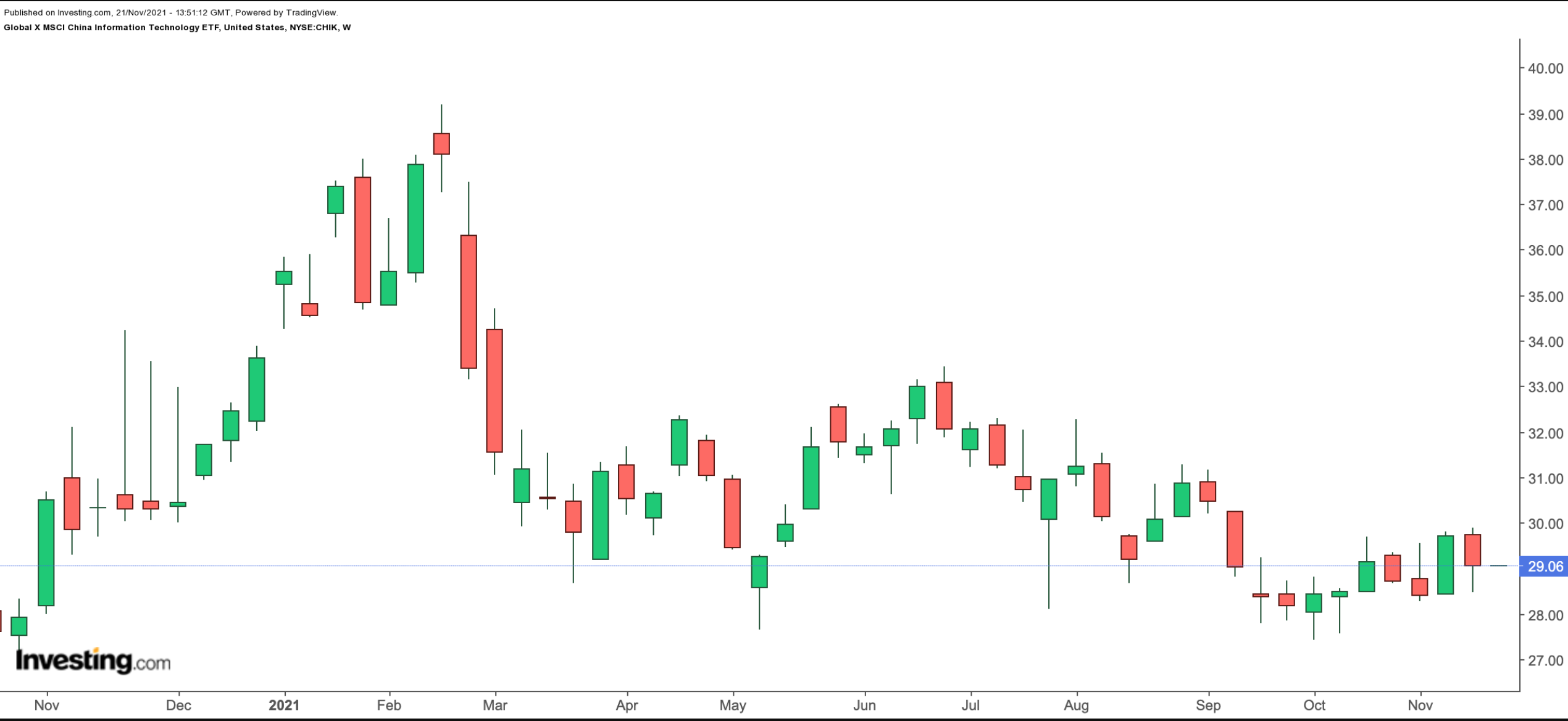Long-term investors in Chinese shares have had a volatile year so far in 2021. The state’s heavy hand on technology, online education and real estate names meant significant pressure for those stocks. For instance, this is how several of the widely-followed Chinese shares have fared year-to-date (YTD).
- Alibaba (NYSE:BABA) - down 39.7% YTD;
- Baidu (NASDAQ:BIDU) - down 29.8% YTD;
- Baozun (NASDAQ:BZUN) - down 50.9% YTD;
- Didi Global (NYSE:DIDI) - down 40.7% since going public in June;
- JD.com (NASDAQ:JD) - up 4.1% YTD;
- New Oriental Education & Technology (NYSE:EDU) - down 88.2% YTD;
- Nio (NYSE:NIO) - down 20.7% YTD;
- Tencent (OTC:TCEHY) - down 12.1% YTD.
On the other hand, the Shenzhen Composite index is up about 6.9% and the Shanghai Composite index returned 2.5%. By comparison the S&P 500 index, which hit a record high in early November, is up 25.1% YTD. Analysts now debate whether global investors could soon begin to turn cautiously optimistic on Chinese equities.
Meanwhile, on Nov. 15, US President Joseph Biden and his Chinese counterpart, Xi Jinping, had a virtual meeting, which was regarded as a positive step in communicating openly despite points of tension between the two countries. After the meeting, the White House readout said:
“the two leaders covered areas where our interests align, and areas where our interests, values, and perspectives diverge…. [President Biden] was clear about the need to protect American workers and industries from the PRC’s unfair trade and economic practices.”
The World Bank notes that over the past four decades, China’s average annual GDP growth has been around 10%, and the country is now “an upper-middle-income country.”
Put another way, despite in-country regulatory woes as well as occasional global disputes, China is an important country for global investors. Therefore, today’s article introduces two exchange-traded funds (ETFs) that could appeal to readers who believe Chinese equities might fare better in 2022.
1. Global X MSCI China Information Technology ETF
- Current Price: $29.06
- 52-Week Range: $27.44 - $39.20
- Dividend Yield: 1.02%
- Expense Ratio: 0.65% per year
According to recent metrics, in the first half of 2021, China’s software and information technology (IT) industry saw record revenues of $682.86 billion, an increase of 23.2% percent year-over-year.
The Brookings Institution suggests that “China’s competitive advantage is their ability to out-bulk the US as 1.5 billion people generate data that can then be repurposed for other applications including artificial intelligence (AI) and new products and services… China has established a national goal to be the world leader in artificial intelligence by 2030.”
Our first fund, the Global X MSCI China Information Technology ETF (NYSE:CHIK) offers exposure to large- and mid-capitalization (cap) Chinese IT firms. The fund was first listed in December 2018.

CHIK, which tracks the MSCI China Information Technology 10/50 Index, currently has 106 stocks. The top ten holdings comprise around 45% of total net assets of over $30 million. In other words, it is a small fund.
The most important sectors in the fund are electronic components (19.56%), semiconductors (17.96%), telecommunications equipment (13.82%), packaged software (13.41%) and computer processing hardware (5.41%).
Leading manufacturer of optical lenses Sunny Optical Technology (OTC:SNPTF); Xiaomi (OTC:XIACF), which manufactures smartphones and and provides Internet services; provider of solar glass Xinyi Solar (HK:0968); Kingdee International Software (OTC:KGDEY), which provides enterprise resource planning (ERP); and Lenovo (OTC:LNVGY), which manufactures personal computers and mobile Internet devices, are among the top names on the roster.
CHIK has declined 3.2% in the past 52 weeks and 13.6% YTD. It also hit a 52-week low on Oct. 6. The fund’s trailing price-to-earnings (P/E) and price-to-book (P/B) ratios stand at 21.86x and 2.28x. Interested readers could consider investing around these levels.
2. SPDR S&P China ETF
- Current Price: $112.26
- 52-Week Range: $106.42 - $156.29
- Dividend Yield: 1.15%
- Expense Ratio: 0.59% per year
The SPDR® S&P China ETF (NYSE:GXC) invests in both “China A Shares” as well as companies that trade as American Depositary Receipts (ADRs) in the US. Most of our readers would know that China A-shares are RMB-denominated stocks that trade on the Shanghai and Shenzhen Stock Exchanges.

GXC, which has 897 holdings, tracks the returns of the S&P China BMI Index. The fund began trading in March 2007.
Companies in the consumer discretionary sector makes up the highest portion with 29.16%. Next in line are communication services (16.96%), financials (13.34%), health care (7.98%). The leading 10 names account for about 40% net assets of $1.69 billion.
Leading social media and entertainment company Tencent; e-commerce heavyweights Alibaba and JD.com; food ordering and delivery platform Meituan (OTC:MPNGY); electric vehicle (EV) group Nio; and China Construction Bank (OTC:CICHF) are among the most important firms in the fund.
In the past 12 months, GXC is down almost 14% and has lost over 13.8% since January 2021. Trailing P/E and P/B ratios stand at 11.90x and 1.72x. Buy-and-hold investors who believe the decline in Chinese shares could be over soon should research the ETF further.
